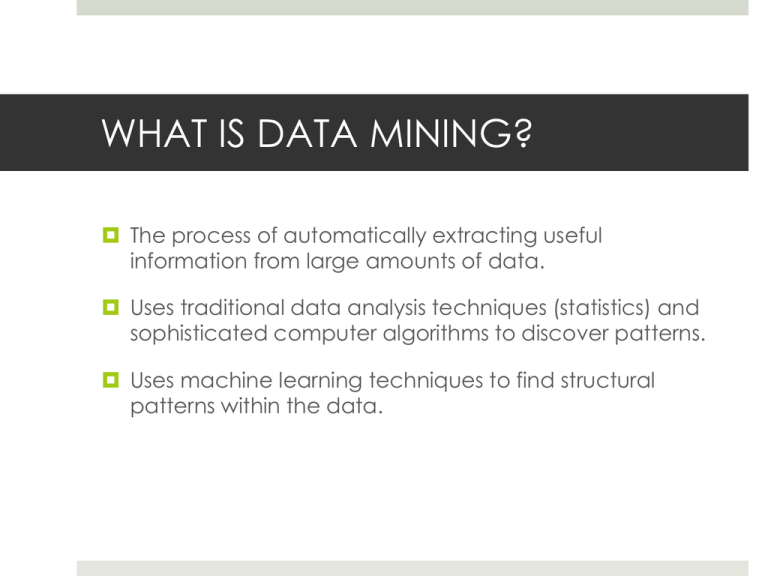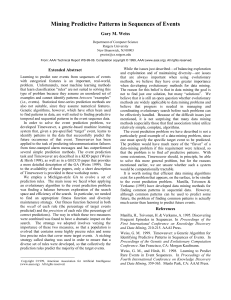Data Mining Introduction
advertisement

WHAT IS DATA MINING? The process of automatically extracting useful information from large amounts of data. Uses traditional data analysis techniques (statistics) and sophisticated computer algorithms to discover patterns. Uses machine learning techniques to find structural patterns within the data. Origins of Data Mining Draws ideas from machine learning/AI, pattern recognition, statistics, and database systems Traditional Techniques may be unsuitable due to Enormity of data High dimensionality of data Heterogeneous, distributed nature of data Statistics/ AI Machine Learning/ Pattern Recognition Data Mining Database systems Cross Industry Standard Process for Data Mining The Process -- Simplified pre-processing, data mining results validation Two Basic Problem Classes Prediction Methods Use some variables to predict unknown or future values of other variables. Description Methods Find human-interpretable patterns that describe the data. Basic Types of Data Mining Tasks Classification (predictive) Clustering (descriptive) Association rules (descriptive) Sequential patterns (descriptive or predictive) Regression (predictive) Anomaly Detection (predictive) Data Mining Techniques Statistical techniques Clustering Decision trees Subsampling (bootstrapping) Nearest-neighborhoods SOM Bayesian methods Data Mining Techniques Artificial Neural Nets Deep Learning (Google DeepMind) PCA Universal Prediction Reinforcement Learning “Compression” Sequence Prediction Techniques Time Series Analysis Data Mining Techniques Hidden Markov Models MLN PLN EDA (MOSES) Random Forests Feature Engineering Unsupervised and Semi-Supervised Learning DATA MINING TECHNIQUES Entropy methods Multifractal methods (time series) Log-linear power laws (crash prediction) Wavelet transforms …. …. …. CLASSIFICATION: Definition Given a collection of records (training set ) Each record contains a set of attributes one of the attributes is the class. Find a model for class attribute as a function of the values of other attributes. Goal: previously unseen records should be assigned a class as accurately as possible. A test set is used to determine the accuracy of the model. Usually, the given data set is divided into training and test sets, with training set used to build the model and test set used to validate it. CLUSTERING: Definition Given a set of data points, each having a set of attributes, and a similarity measure among them, find clusters such that Data points in one cluster are more similar to one another. Data points in separate clusters are less similar to one another. Similarity Measures: Euclidean Distance if attributes are continuous. Other Problem-specific Measures. REGRESSION: Definition Predict a value of a given continuous valued variable based on the values of other variables, assuming a linear or nonlinear model of dependency. Greatly studied in statistics, neural network fields. Examples: Predicting sales amounts of new product based on advetising expenditure. Predicting wind velocities as a function of temperature, humidity, air pressure, etc. Time series prediction of stock market indices. DATA MINING CHALLENGES Scalability Dimensionality Complex and Heterogeneous Data Data Quality Data Ownership and Distribution Privacy Preservation Streaming Data





